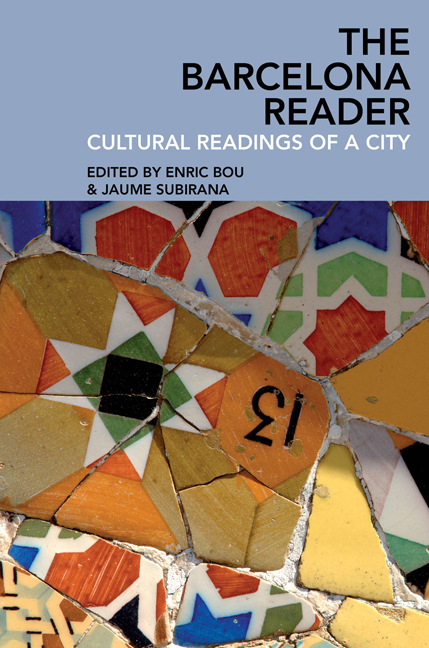Book contents
- Frontmatter
- Contents
- List of illustrations
- Notes on contributors
- Introduction: Barcelona: Cultural readings of a city
- I City, history, and territory
- 1 Barcelona: The siege city
- 2 Barcelona as an adaptive ecology
- 3 A present past, Barcelona street names, from Víctor Balaguer to Pasqual Maragall
- 4 ‘The asylum of modern times’: Barcelona and Europe
- 5 A fragile country
- II City and society
- III Art, architecture, and the city
- IV The Olympics and the city
- V Literature, cinema, and the city
3 - A present past, Barcelona street names, from Víctor Balaguer to Pasqual Maragall
from I - City, history, and territory
- Frontmatter
- Contents
- List of illustrations
- Notes on contributors
- Introduction: Barcelona: Cultural readings of a city
- I City, history, and territory
- 1 Barcelona: The siege city
- 2 Barcelona as an adaptive ecology
- 3 A present past, Barcelona street names, from Víctor Balaguer to Pasqual Maragall
- 4 ‘The asylum of modern times’: Barcelona and Europe
- 5 A fragile country
- II City and society
- III Art, architecture, and the city
- IV The Olympics and the city
- V Literature, cinema, and the city
Summary
In his essay, The Idea of Europe, the critic George Steiner writes:
The streets, the squares walked by European men, women and children are named a hundredfold after statesmen, military figures, poets, artists, composers, scientists and philosophers. […] The European schoolchild, urban men and women, inhabit literal echo-chambers of historical, intellectual, artistic and scientific achievements. […] Cities such as Paris, Milan, Florence, Frankfurt, Weimar, Vienna, Prague or Saint Petersburg are living chronicles. To read their street-signs is to leaf through a present past. (Steiner: 41–42)
Steiner writes that in Europe, unlike in America, there is a real ‘sovereignty of remembrance’, and that the continent defines itself as a lieu de mémoire, using Pierre Nora's expression. This was the affiliation (the genealogy) of the city as a living chronicle and as a place of memory that was aspired to in the latter half of the nineteenth century by the Barcelona that had recently approved the major urban planning reform of the Eixample; the Barcelona, too, of the Jocs Florals (Floral Games, reinstated in 1859) and the imminent 1888 Universal Exposition. And it was also largely this affiliation, as we shall see, to which the Catalan capital aspired on the occasion of the changes at the end of the twentieth century, bringing about the return of democracy and the awarding to the city of the organization of the Summer Games of the XXV Olympiad. This article analyses the ‘christening’ of the streets in the Eixample, in the second half of the nineteenth century, and of the Vila Olímpica at the end of the twentieth century.
Naming a city's streets is a semiotic and political operation (Azaryahu) and a ‘performative practice that produces a contested space of political utterances’ (Rose-Redwood: 890). Street names tell a kind of story, a narrative of varying degrees of coherence that is often a ‘message’ on the part of planners, and we can study how successful it has been in its incorporation into the imaginary of the city and its citizens. In City of Glass (1985), one of Paul Auster's characters spends two hours walking around New York, tracing out an itinerary in the form of a huge letter on a plan of Manhattan Island, and the sum of the days and the letters is a message with a meaning.
- Type
- Chapter
- Information
- The Barcelona ReaderCultural Readings of a City, pp. 71 - 90Publisher: Liverpool University PressPrint publication year: 2017



